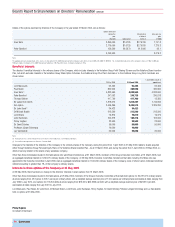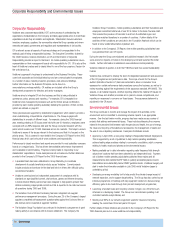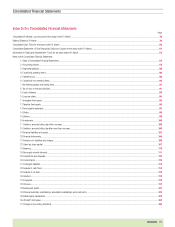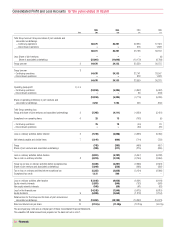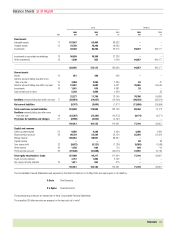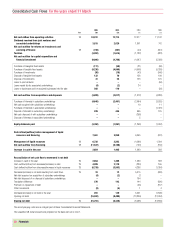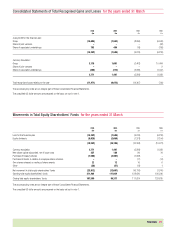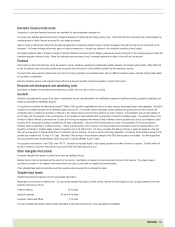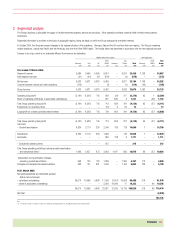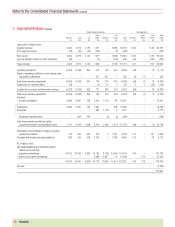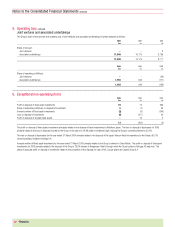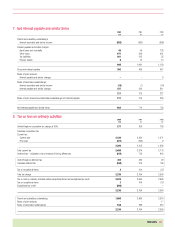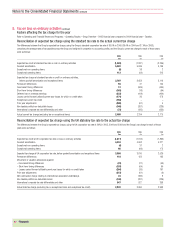Vodafone 2005 Annual Report Download - page 85
Download and view the complete annual report
Please find page 85 of the 2005 Vodafone annual report below. You can navigate through the pages in the report by either clicking on the pages listed below, or by using the keyword search tool below to find specific information within the annual report.
Financials |83
Derivative financial instruments
Transactions in derivative financial instruments are undertaken for risk management purposes only.
The Group uses derivative financial instruments to hedge its exposure to interest rate and foreign currency risk. To the extent that such instruments are matched against an
underlying asset or liability, they are accounted for using hedge accounting.
Gains or losses on interest rate instruments are matched against the corresponding interest charge or interest receivable in the profit and loss account over the life of the
instrument. For foreign exchange instruments, gains or losses and premiums or discounts are matched to the underlying transactions being hedged.
Termination payments made or received in respect of derivative financial instruments held for hedging purposes are spread over the life of the underlying exposure where the
underlying exposure continues to exist. Where the underlying exposure ceases to exist, termination payments are taken to the profit and loss account.
Pensions
Costs relating to defined benefit plans, which are subject to periodic valuations calculated by professionally qualified actuaries, are charged against profits, within staff costs
so that the expected costs of providing pensions are recognised during the period in which benefit is derived from the employees’ services.
The costs of the various pension schemes may vary from the funding, dependent upon actuarial advice, with any difference between pension cost and funding being treated
as a provision or prepayment.
Defined contribution pension costs charged to the profit and loss account represent contributions payable in respect of the period.
Research and development and advertising costs
Expenditure on research and development and advertising is written off in the year in which it is incurred.
Goodwill
Goodwill is calculated as the surplus of fair value of consideration over fair value attributed to the identifiable net assets and liabilities (excluding goodwill) of subsidiary, joint
venture and associated undertakings acquired.
For acquisitions made after the financial year ended 31 March 1998, goodwill is capitalised and held as a foreign currency denominated asset, where applicable. Goodwill is
amortised on a straight line basis over its estimated useful economic life. For acquired network businesses, whose operations are governed by fixed term licences, the
amortisation period is determined primarily by reference to the unexpired licence period and the conditions for licence renewal. The amortisation periods range between 3
and 20 years, with the exception of the goodwill arising on the formation of Verizon Wireless and the acquisition of interests in Vodafone Japan. The goodwill arising on the
formation of Verizon Wireless is amortised over 25 years as the Group has assessed the renewal of Verizon Wireless’ licences as perfunctory and as such believes a useful
economic life for the acquired business of greater than 20 years is appropriate. During the 2005 financial year, as a result of the acquisition of the minority stakes in
Vodafone Japan as described in “Business Overview – History and Development of the Company”, the Group reviewed the amortisation period for goodwill arising on the
acquisition of interests in Vodafone Japan, including acquisitions prior to 31 March 2004. The Group concluded that although licences in Japan are issued for a five year
term with a presumption of renewal where there is a continuing need for spectrum, the licence issued is technology dependent. Accordingly, the amortisation period for this
goodwill was increased from 16 years to 21 years. The effect of this change on the amortisation charge for the 2005 financial year is not material. For other acquisitions,
including customer bases, the amortisation period for goodwill is typically between 3 and 10 years.
For acquisitions made before 1 April 1998, when FRS 10, “Goodwill and Intangible Assets”, was adopted, goodwill was written off directly to reserves. Goodwill written off
directly to reserves is included in the profit and loss account when the related business is sold.
Other intangible fixed assets
Purchased intangible fixed assets, including licence fees, are capitalised at cost.
Network licence costs are amortised over the periods of the licences. Amortisation is charged from commencement of service of the network. The annual charge is
calculated in proportion to the capacity of the network during the start up period and on a straight line basis thereafter.
Other intangible fixed assets are amortised over their expected useful economic life on a straight line basis.
Tangible fixed assets
Tangible fixed assets are stated at cost less accumulated depreciation.
Depreciation is not provided on freehold land. The cost of other tangible fixed assets is written off from the time they are brought into use, by equal instalments over their
expected useful lives as follows:
Freehold buildings 25-50 years
Leasehold premises the term of the lease
Equipment, fixtures and fittings 3-10 years
The cost of tangible fixed assets includes directly attributable incremental costs incurred in their acquisition and installation.



